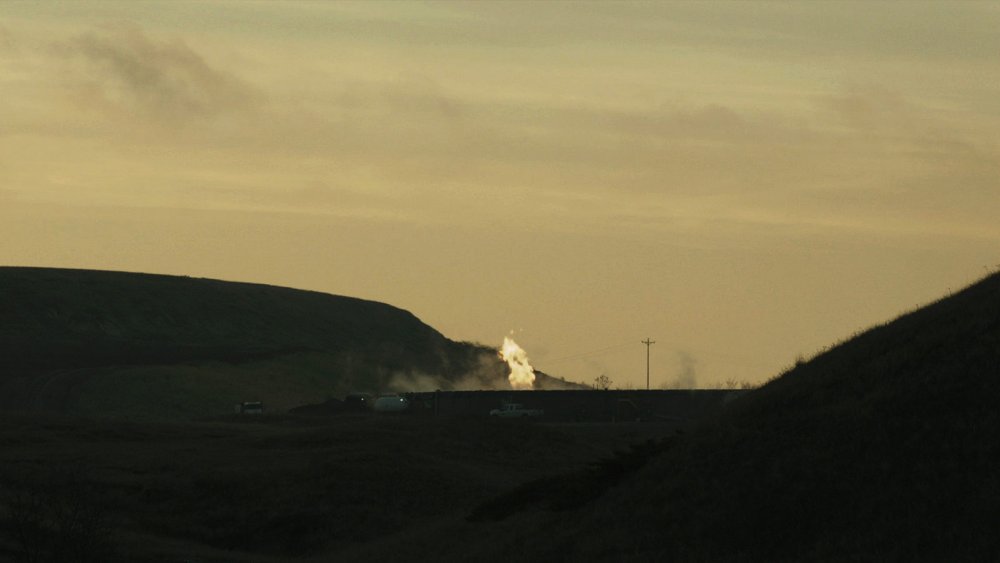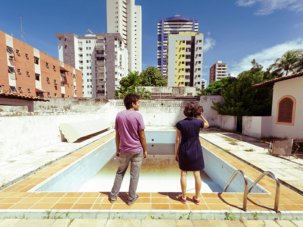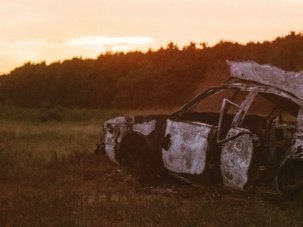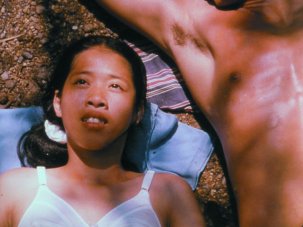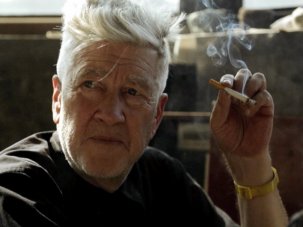Experimental film Gray House is a collaboration between director Austin Lynch and cinematographer Matthew Booth, who met through art school and have been working on the project for four years. Loosely cinematic nonfiction, the film eludes genre as it moves through landscapes to spend time with remote oil-rig workers in one isolated pocket of America, and female prisoners in another. Denis Lavant grafts on a fishing boat, while a young woman navigates to a remote swimming spot. Gray House is ambiguous and open and shifts seamlessly from constructed sequences to more straightforward documentary content. There are no direct interconnections, only than a prevailing mood.
Gray House screened in the BFI London Film Festival on 7 and 8 October 2017.
Matthew Booth’s photography is stunning, capturing natural colour blends evocative of screen printing, and remote boxy structures reminiscent of William Eggleston. The score was composed by experimental musician Alvin Lucier, and is intricately structured: at times rumbling viscerally, ebbing and flowing through the narrative with harmony and dissonance. Gray House is a hypnotic description of spaces, and the experience of living within these distinctive environments.
I asked them both to tell me a little more about the film.
On the origin of Gray House
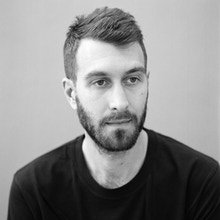
Austin Lynch
Credit: Kickstarter
Austin Lynch: The film sort of began with the idea to marry the structure with the subject matter. From thinking about spaces where people live in different ways and different ways of living, to come up with a structure that did two things – like an architecture in and of itself. And also these mixed, different modes of working: sequences structured around interviews and sequences that were following actors as they move through a space, and watching them. To explore the material of the film, the medium itself as much the material of these environments and characters.
Matthew Booth: We weren’t setting out to communicate a certain message. The goal was more making something open, than something tied down to an idea that we’re expressing. But certainly, especially thinking about the documentary sections of the film, the reality of these people’s lives is an isolated existence.
Al: I think isolation is a part of a lot of these environments, and the reality of those spaces. But to describe those spaces, and those ways of living, was the project, and to get at some of the complexity that surrounds them rather than say this is what its about… To try to live in that and feel all of the different feelings that are there.
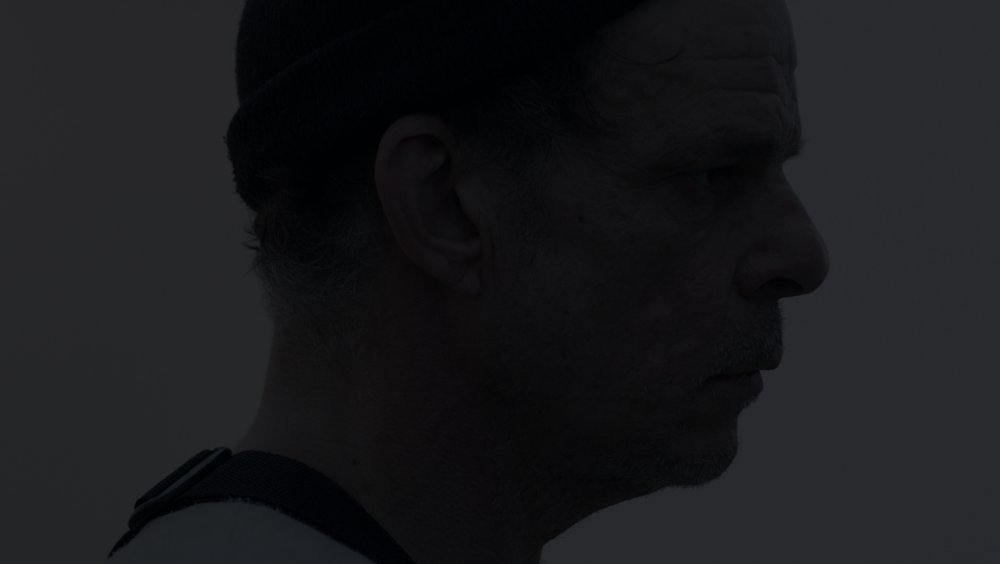
Denis Lavant in Grey House
MB: Many of the decisions we made when making the film were towards the spirit of openness. And maybe partly it has something to do with an idea of respect and of not wanting to reduce the complexity of these real people’s experience to something so tied-down and narrow. I think in my experience the more time we spent in these environments, the more the complexity of the reality revealed itself to us. So we certainly didn’t go into each space with any prescribed idea of what it was and I don’t think we left with any idea like that either. Just an appreciation of the complexity of each situation and the inter-relatedness of it all or something too.
On sound and the score
AL: I think that a lot of where we were working – the shrimp boat in Texas and the community in Virginia – there was just naturally a world of really interesting complex sound, and so you had to try and create a sound world for the film that was as immersive as the pictures were. And again the hope is that there would be the potential to enter the film as a viewer and to live in it. And that’s picture and sound and structure as well. But to really build up and describe those spaces through sound was a great project.
MB: It’s one of the mechanical parts of filmmaking that makes you aware of your body, when you’re in the audience, watching a movie. To feel the sound makes you aware of your body. And the shot length of the film is so long and these long takes also make you aware, at a certain point you become aware of how long it’s going on, and how long you’re sitting there looking at this thing, so there are some aspects like that that might hopefully immerse you in the world of the film but also simultaneously make you self-aware, or it puts you into your head a little bit too, which I think is interesting.
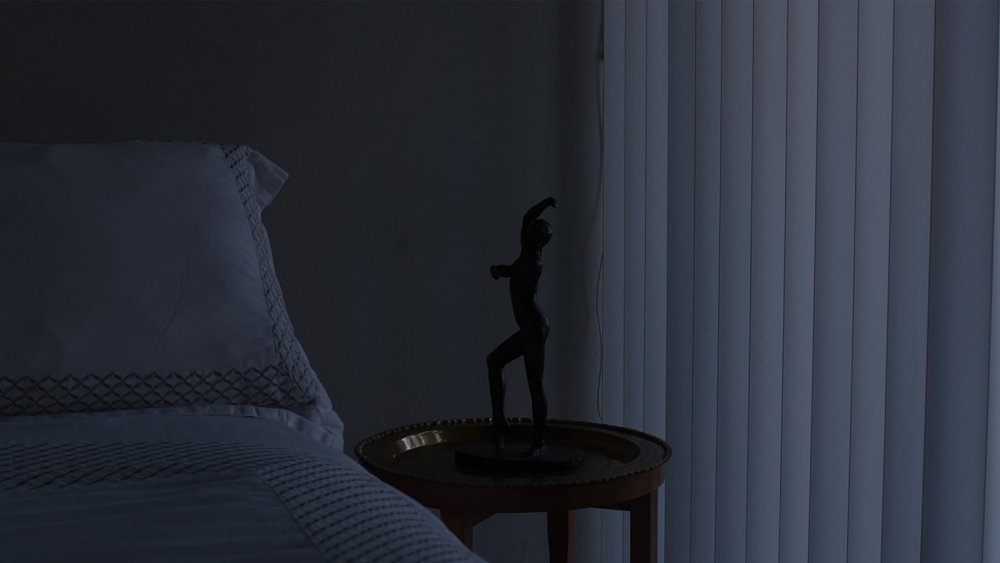
Gray House (2017)
AL: The music that’s in the film is composed by Alvin Lucier. His work is extremely structural and pre-determined and we thought it related to the film in those ways. But it is somewhere between what you think of as music and what you think of as action itself. The hope was to create a relationship to music that obviously pushed the conversation about constructed sequences and more documentary sequences, but that worked in a way that wasn’t music for the film, yet still pushed it and complicated it in some of the same ways.
MB: I think we really resist film music that feels very manipulative or emotive. But I think with the Lucier music, it exists as its own kind of discrete thing. At times it aligns or seems in phase with the film and then other times it’s out of phase and then feels more like two elements in relationship with each other, than one that exists just to push experience.
On the cinematography and shooting in the ‘magic hour’
MB: In my photographic work I print everything. I’m so accustomed to photographing in order to imagine the print, or the experience in a cinema in this case. I think there’s something… I mean again it’s about intentionality and I don’t want to wade deeply into that water, but I definitely think that the ambiguity between dawn and dusk is interesting and a potentially meaningful time of day. It’s a time of day where, in my experience, the light takes on certain colours that can feel so unnatural and so alien and make things feel unreal or unearthly, even though it may be totally unmanipulated. And that is another ambiguity that I’m fascinated by: the ambiguity between something that is and isn’t manipulated, or a feeling of unnaturalness that is totally truthful.
On the participation of the interviewees
AL: In North Dakota we were staying inside one of these worker housing complexes that were commonly referred to as ‘mancamps’ in the area. We were there for about three weeks, and we would meet in the residents hall, and meet people around, mainly where we were staying, and these were people who worked on the rigs or the frack site and that’s largely how we met the guys in North Dakota.
And then in the prison, in Oregon, we were in communication with the staff at the prison and so were able to organise a number of interviews with inmates who were serving life sentences or long-term sentences that were willing to speak and wanted to participate in the film and to talk about their experiences. But it was much more formal there because the situation is such that it really needs to be.
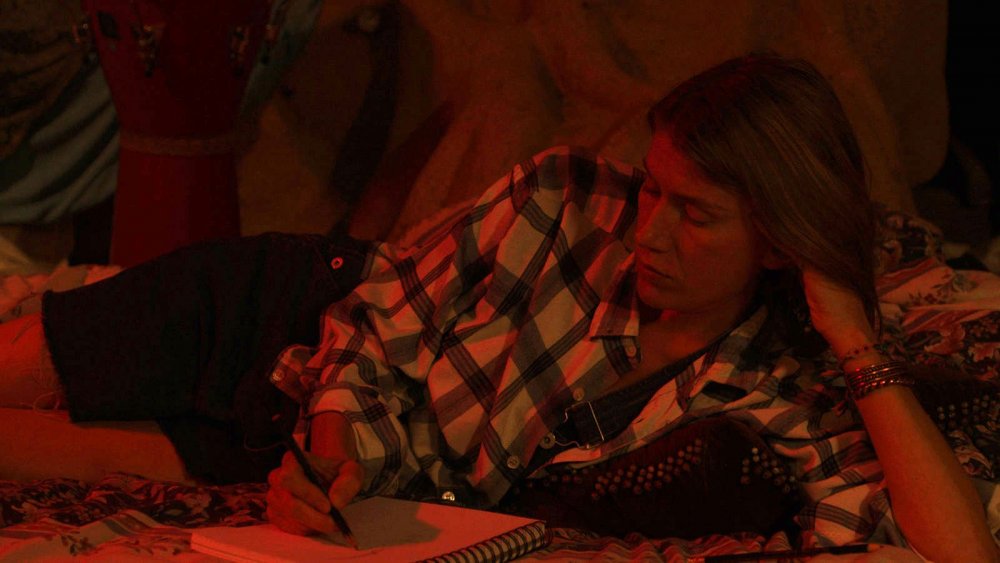
Gray House (2017)
MB: For me it was just a really powerful experience to meet these people and as much as you try not to you can’t help but enter every situation with a certain set of preconceptions or at least ideas about what the experience might be like. But for me the experience of meeting them was just: “Oh, these people are just like me and like everyone I know.”
And I know that part of the reason we were able to work in that institution is that we didn’t really have an agenda, our interest certainly wasn’t in the crimes these people have committed, it was more in the realities of the lives that they’ve made for themselves in these completely exceptional circumstances. Just going in and trying to talk to people as people instead of as any other label.
On the film’s sense of time and rhythm
AL: Time is almost a material in and of itself. And it’s obviously it’s a huge part of film as well, but time is maybe the most mysterious aspect of the film and of the project. And I think it relates to the changing light, the time of day and how the film moves in that way as well.
On the more staged aspects of the film
AL: A lot of the structure of the film and the specific subject matter of ‘this location… [then] this location’ evolved in a very intuitive way, almost like a painting. It was about creating a kind of composition – that you moved through these environments in a certain way – and thinking a lot about how the way that a house or some place you live comes to mediate a relationship with the natural world or nature.
In the beginning of the film, Denis Lavant’s character has such a direct connection to the environment, a very direct relationship to his surroundings and to the nature, and then in the prison, Patty speaks so much about being disconnected from the trees and the mountains that she loved so much. A really powerful moment in the film is the cut from the river in Virginia to the prison itself and you see that huge shift in environment. So this connection to nature and the different ways that we are connected to it was definitely in the air, when we were structuring the film and thinking about its movement through these five places.
-
BFI London Film Festival 2017 – all our coverage

Follow all our coverage of the 61st London Film Festival, including reviews of the top films, interviews with their makers and blog posts from our...
-
The Digital Edition and Archive quick link
Log in here to your digital edition and archive subscription, take a look at the packages on offer and buy a subscription.




